Moon
Orbit Extremes
Since the arrival of Planet X in the inner solar system in
2003, the Moon’s orbit has taken an extreme tilt. The Moon's
orbit has become more extreme since that time. For a given
location, the Moon’s Face should rotate not more than 7° 7' but
it is regularly seen with a 90° rotation now. This was last
covered in Issue 354 of this
newsletter on July 14, 2013. The rotating face is the most
commonly noted feature of the erratic Moon orbit, easily
identified by the man in the streets. Plotting the Moon’s orbit
by astrophysics is a bit more technical, but shows the same
extremes. The Moon travels in a nearly circular orbit, around
the Earth's middle with only a c offset from the Ecliptic. It
has been the guide, for the past decade, that the Full and New
Moon are close to where expected.
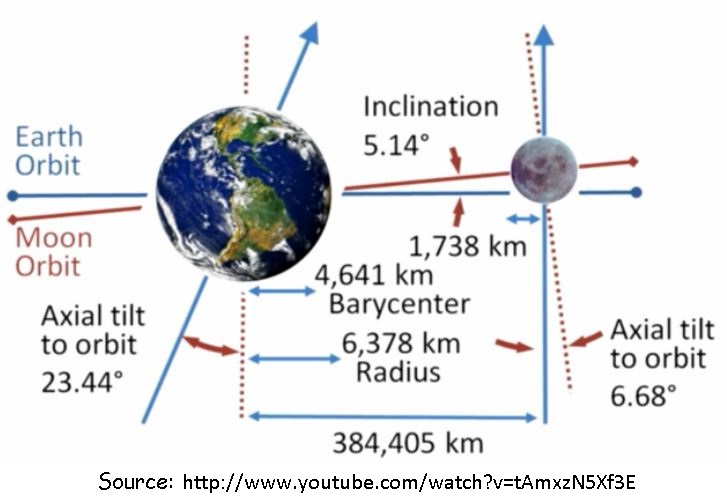
This past decade the orbit, like a hat tilted offset on a head,
was consistently reported to be too far North when waxing after
a new Moon, and too far South during waning after a full Moon.
Other than noting that the Moon had never shown over Uncle Bob’s
barn before, or in the North facing window, the common man does
not track the Moon’s location. Some excellent documentation was
recently provided by a YouTube
report that shows the Moon’s location. The old pattern of
finding the Moon where expected at Full and New Moon has
changed! On July 22, 2013 the Full Moon was identified at Dec
-15, below the Ecliptic. Moving rapidly it swung to Dec +19 by
August 3, 2013 for the Crescent Moon, some two weeks later. Two
weeks or so after that on August 18, 20013 the Full Moon had
swung South of the Ecliptic again to Dec -15. The swings should
be no greater than 5° from the Ecliptic, but now were swinging
at Full and New Moon some 34°! The actual location of the Moon
is diagramed on this YouTube
video to show the variation in where the Moon was located
on August 7 and 8, 2013. These types of swings are a new
extreme.
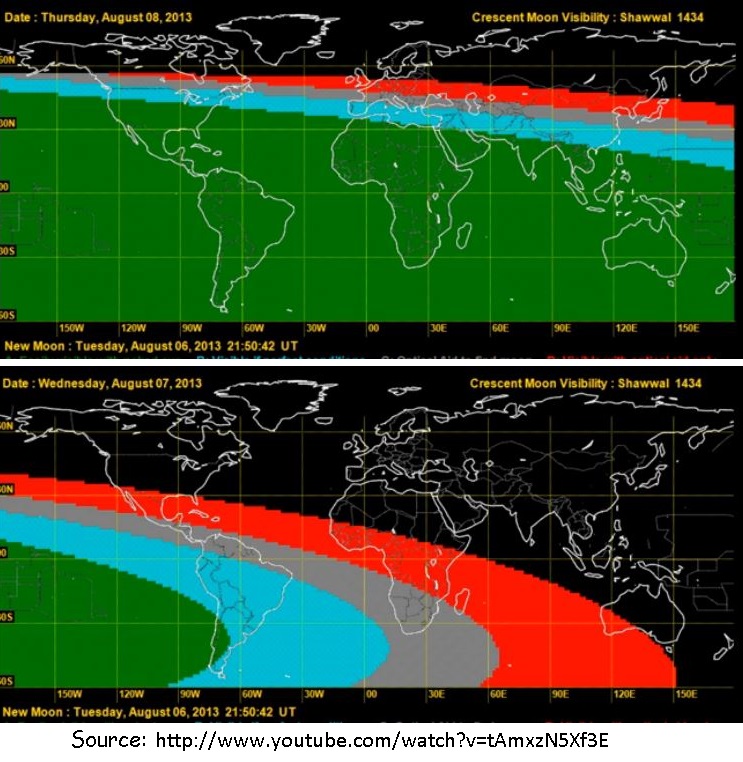
Alberto has also noted extreme positions of the Moon, as noted
in the Pole
Shift ning blog devoted to Moon watching. On July 17, 2013
when the Moon was waxing halfway to Full, it should have been at
Azimuth 201, but was discovered at Azimuth 149, 50° too far to
the South! Just one day later it had swung to be at Azimuth 168
within 14° of where expected at Azimuth 183. Of course, the
noted tilt over the past decade has been for the Full Moon to be
where expected, so this movement is in accordance with that
rule. But 50° too far to the South? Wow.
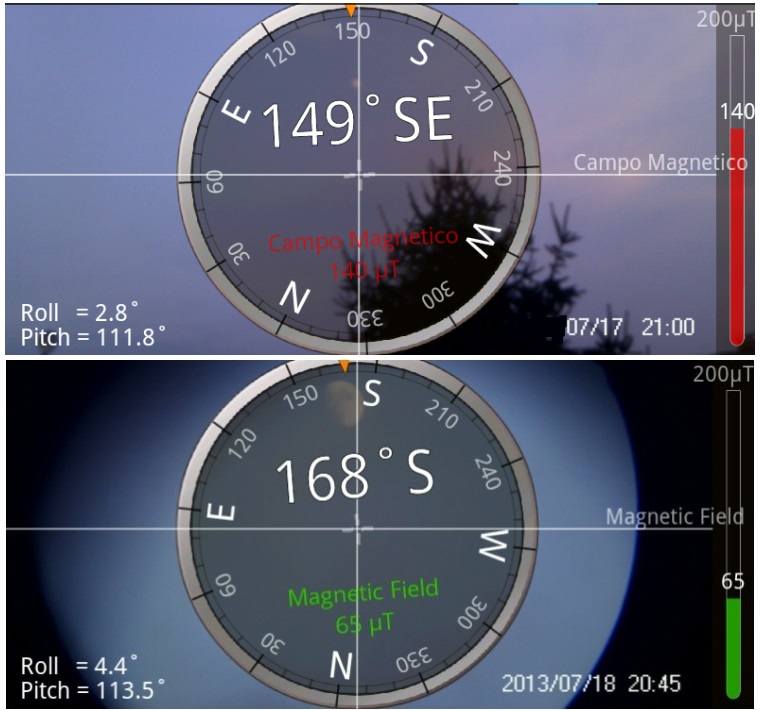
A FaceBook
page devoted to Moon watching notes aberrations too. From
Toronto on August 16, 2013 the Moonset is over an hour late! On
August 19, 2013 the Moon should have been almost full, 95%
illumination, but per the photo taken from Toronto at 1:18 am is
far less than the 95%
expected, as is a photo taken in nearby Mississauga. The Moon is
out of position!
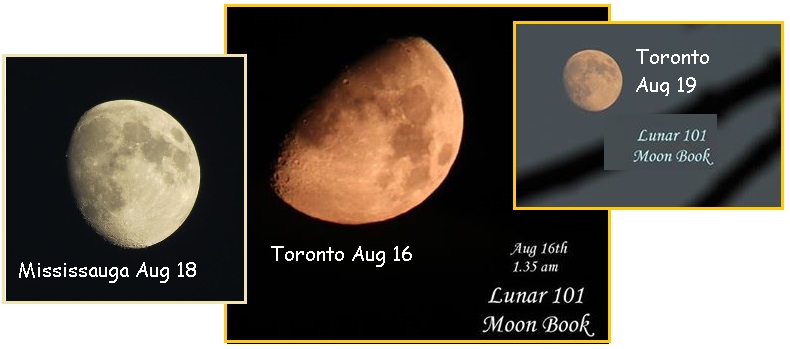
- Aug 16: 1.35 am 1 hour and six
minutes after Moonset and still in the sky in Toronto
Aug 18: Taken tonight in Mississauga 9:00 pm
Continuous Quake
Zones
In Issue 358 on August 11, 2013 we
listed what the Zetas had revealed about the 8 of 10 phase,
which is overlapping the 7 of 10 at the present time. Continuous
plate movement in some regions was mentioned, with no specifics
as to what these regions might be.
ZetaTalk Prediction
5/29/2010: During
an 8 of 10, where significant plate movement in one area does
not start and stop, but just keeps going.
ZetaTalk Prediction
10/8/2011: We
have hinted that continuous plate movement will be a factor
during the 8 of 10, but declined to give more details on
location or extent or such movement.
It would appear, from the seemingly continuous activity during
the past few months, that New Zealand is one of those zones!
First there were the hints in May that a slip-slide plate border
had been “rolling all year”.
- Long-Running Wellington Quake a
'Slow-Slip' Event
May 27, 2013
http://www.nzherald.co.nz/nz/news/article.cfm?c_id=1&objectid=10886581
- The biggest earthquake in 150
years is hitting Wellington at the moment, but none of the
locals are diving under desks or sheltering in doorways.
The magnitude 7 quake is centred to the west of the
capital and is 40km deep, and has been rolling all year.
Then after a 6.5 quake on July 22, 2013 there were so many
aftershocks (over 100) that it begged the question – is New
Zealand one of those regions?
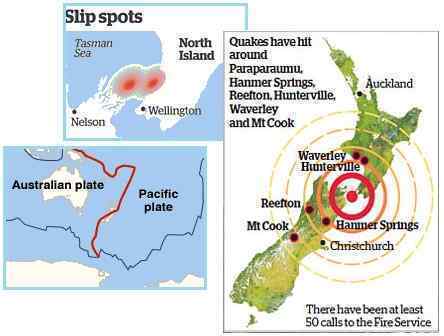
- Wellington Earthquake: We can Afford
New Quake Damage
July 22, 2013
http://www.nzherald.co.nz/nz/news/article.cfm?c_id=1&objectid=10901290
- Aftershocks continue to plague
Wellington and the top of the South Island the 6.5
magnitude jolt which struck in the Cook Strait. More than
100 aftershocks have been recorded since, including a 5.0
which hit 15km east of Seddon.
ZetaTalk Answer
7/27/2013: We
have described the 8 of 10 as being a phase where some parts
of the globe are continually in motion, without rest. In that
the Indi-Australian Plate is the brake, holding all other
plate movement back, it is certainly one of those places.
On August 16, 2013 the pattern repeated after a 6.5 quake in New
Zealand. This was followed almost immediately by a 7.3 to the
east of the New Zealand fault line, along what the Zetas
described as the true border of the Indo-Australian Plate at New
Zealand. Once again, aftershocks galore. Continuous movement
region, indeed!
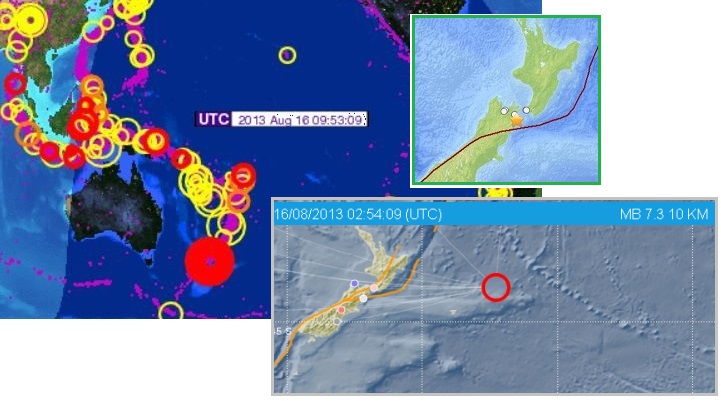
- M6.5 - 29km SSE of Blenheim, New
Zealand
August 16, 2013
http://earthquake.usgs.gov/earthquakes/eventpage/usb000j4iz#summary
- The M 6.5 earthquake south of
Blenheim, New Zealand, occurred as the result of
strike-slip faulting on or near the plate boundary between
the Pacific and Australia plates.
Antarctica Roll
During the 8 of 10 discussions, the Zetas mentioned continents
changing their positions relative to one another, but declined
to state at the time which continents would be involved.
ZetaTalk Prediction
4/9/2011: The
exact position of the continents is not in complete accordance
with their post Pole Shift alignment, however, but to detail
these changes would be getting into the 8 of 10 scenarios
prior to the time when we are ready to discuss these
scenarios.
The Zetas have now revealed one
of the continents involved. Well, actually, they’ve indicated
which continents would be involved in a virtual dance, as
Antarctica touches on so many. It was noted in the news that an
unusual high tide was experienced along Australia’s southern
coastline and Tasmania. Since the establishment had no other
explanation, they pointed to the usual excuse - the
weather. But the waves were so
high that it hit the news. Was something else going on?
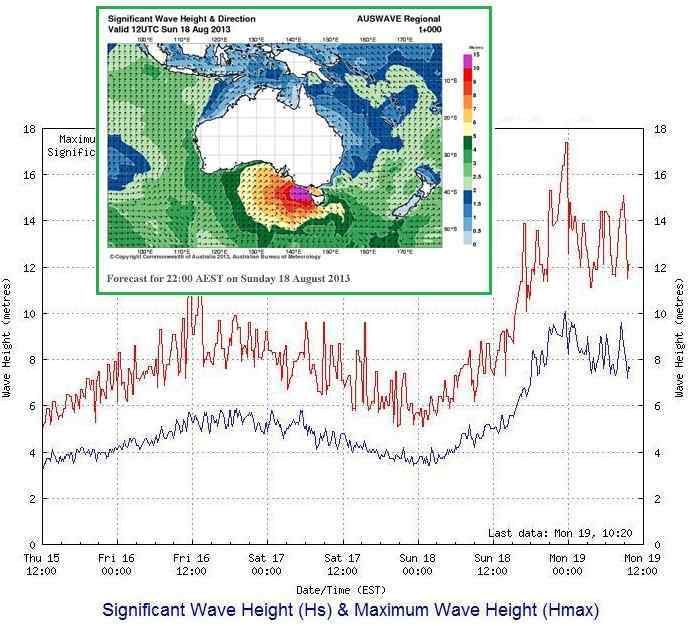
- Wild Winds, Heavy Rain to Batter
Victoria for Days
August 18, 2013
http://www.theage.com.au/environment/weather/wild-winds-to-batter-victoria-20130818-2s4l8.html
- Victoria faces more wild weather
with rain and high winds forecast for the next few days.
- King of all Tides
May 1, 2002
http://www.abc.net.au/science/articles/2002/05/01/2683462.htm
- The king of all Australian tides
occurs near the town of Derby in King Sound, in north-west
Australia, at the end of March and again at the end of
April each year. Derby's tides can reach up to 11.8 m, and
are the second biggest tides in the world (the largest,
clocked at 15 m, occur in the Bay of Fundy, Nova Scotia).
Per the Zetas a rolling of the Antarctic Plate was
responsible.
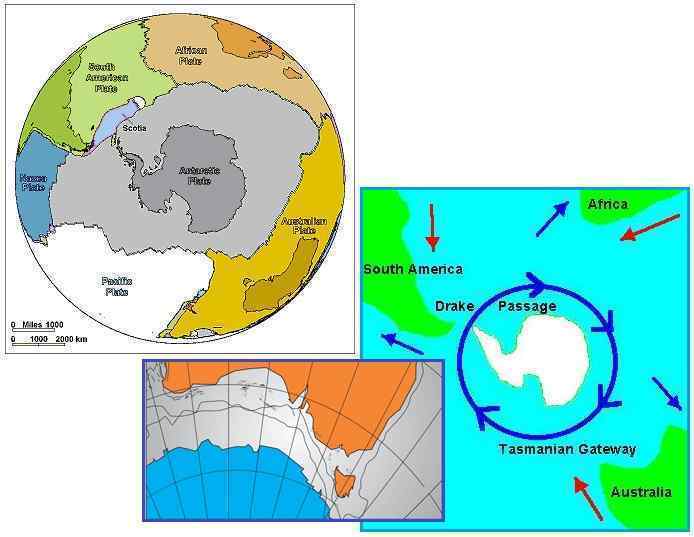
ZetaTalk Explanation
8/24/2013: This
is reported to be a storm surge, but how much of this high
tide is caused by the Earth wobble or plate movements? The
graphs show a tidal surge on August 16, 2013 when there was a
rash of earthquakes in New Zealand, but no such quake swarm
occurred on August 19, 2013 when a larger high tide occurred.
We mentioned during the 8 of 10 discussions that there would
be some shifting of plates during the 8 of 10 such that the
alignment of continents to each other would change. The
Antarctic Plate is one that is relatively free to move, not
being locked on any side.
Due to the S American roll,
which is caused by the spreading Atlantic, there is a natural
tendency of the Antarctic Plate to roll counterclockwise,
pushing the tip of S America toward Africa. We have mentioned
that the compression in the Pacific Plates tips the Antarctic
Plate also, which ultimately results in new land emerging
between the tips of S America and Africa. As this roll of the
Antarctic Plate begins, it will also tend to push under the
Indo-Australian Plate, which is in any case lifting on its
eastern edge and thus providing an opening for the Antarctic
roll. If such a nudge up occurs, the water atop the
Indo-Australian Plate will slosh, and this is what occurred on
August 19 near Tasmania.
Indeed, the Zetas hinted at Antarctic moves early in the
ZetaTalk saga in 1999, when they were describing how new land
would pop up between the tip of S American and Africa as a
result of compression in the Pacific.
ZetaTalk Prediction
2/15/1999: The
Antarctic plate finds the side abutting the Pacific under
pressure, as the plates due to fold or crumble or subduct in
the Pacific begin to do this. This in effect is forcing the
Antarctic plate to fold itself, like a fan, and it resists
this pressure to fold. The tendency is rather for the
Antarctic plate to break away from these bordering plates, so
it then becomes free to move. Likewise, along the Atlantic,
the spreading plates in the Atlantic are asking the Antarctic
plate to rip apart, which it resists, being a very solid
plate. The point that gives, the weak point, is the border
between the Antarctic plate and those in the Atlantic, as
these are already weakened points. Thus, these weak points
separate, the Atlantic plates going their way, the Antarctic
staying in place. The Antarctic plate is now free on all
sides! The overlapping and compressing plates on the Pacific
side represent pressure and push. The separating and spreading
plates on the Atlantic side represent an opening, so the
Antarctic plate moves in that direction.
Maggots
Eating bugs and worms was a top ZetaTalk suggestion when they
began discussing the coming Pole Shift and associated starvation
that the Earth changes will cause on Earth. After all, on their
home planets in Zeta Reticula, bugs and moss were a staple on
their dimly lit planets. Bugs are universally eaten by other
species, and did you know that crabs and shrimp are part of the
bug family? Many human cultures consider their local bugs a
delicacy, and recipes abound.
Even the UN has begun recommending that starving countries look
into the practice. Bugs are sky high in protein and fat. Easiest
to catch are maggots or grubs, and a woman in Austria has
developed a kitchen breeder to easily grow and collect them.

- Anyone for a Bowl of Maggots?
July 31, 2013
http://www.dailymail.co.uk/health/article-2382034/Farm-432-machine-uses-maggots
- The cooked larvae smell like
starchy potatoes with a nutty and meaty taste. The machine
is designed to be the perfect environment for flies and
their larvae allowing in enough light and space for them
to grow. To begin with, you simply drop some black soldier
fly larvae into an appliance chamber. Here they grow and
then move to a larger chamber, mate and produce larva.
This falls down into a separate area, where it matures,
moves on up a tube, and falls into a cup. Some larvae are
dropped back into the machine to restart the process,
while the rest are ready to eat. Black Soldier flies were
chosen as they are easy to breed and contain up to 42 per
cent protein - double the amount in the average
chicken breast - and a high level of calcium and amino
acids. A gram of Black Soldier fly eggs can become 2.4
kilograms of edible protein after 432 hours in the Farm
432. But if Black Soldier flies aren’t to your taste then
other larvae may be used in the same way.
Per the Zetas, one can make dishes from grubs that would pass
as egg and cream based dishes.
ZetaTalk: Suggestion
7/15/1995: Food
stuffs that will do quite nicely on the gloomy light supplied
by the Sun are mushrooms, earthworms, and various insects that
feed on dead tissue. After the cataclysms bugs will be in
abundance, as dead tissue from both plants and animals is
everywhere. This trend can be taken advantage of, as
distasteful as that concept might be to humans who have never
eaten a bug. Larva, grown in humus, can be turned into pureed
and creamed soups, puddings, or omelets by skilled cooks.
Those eating the fare would never guess that the base was not
cream, milk, and eggs.
- The Passage: On the Move
http://www.zetatalk.com/passage/passage8.htm
- Martha has a bowl filled with the
white grubs which are twisting from side to side. Martha
takes a large spoon and starts mashing the grubs, then
frothing them with a fork. Martha pours the frothed grubs
into the pan, and holds it over the fire, stirring
feverishly. When the mess looks like cooked egg whites,
she quickly turns and scoops it onto a platter, pulling a
sprig of some herb she has collected during the day from
her pocket as a garnish. “And for desert we have pudding.”
My personal experience with eating bugs and worms occurred
about a decade ago when we had a Japanese chef visiting for 6
months in order to develop earthworm
recipes. Many lessons later, we had learned that where
earthworms will grow in compost, one must extract the egg sacs
after the young hatch or the sacs act like a natural birth
control device signaling that the population is getting too
large. (The egg sacs are nature's best fertilizer, so put them
in the garden!) Red wigglers are the best worm base for compost
piles, which should include plant matter, not animal fats.
Remember, the herd is silent and will not stampede. Lots of
advantages.
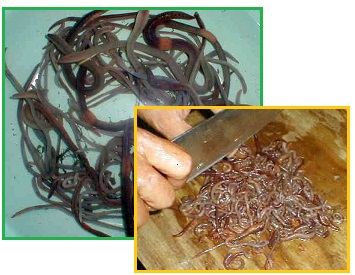
Earthworms require sand to digest, so to remove the grit chop
them up and rinse well. We tried the purge in cold water and it
did not seem to work. Yes, they have blood, and this rinses away
as well. Remember, fresh steak has blood too. Thus prepared, one
has the meat which is 82% protein, and has Omega-3 as the
essential oil. They are virtually tasteless, or if pressed I
would say taste faintly like chicken. Mixing the meat parts in
soup worked well. My favorite story is of offering a roofer who
had come to repair a leak a cup of our new chicken soup recipe.
After slurping it up, he nodded and said it was good but “needed
more chicken”. Then he froze, as he had heard the stories about
our activities, and said “this ain’t one of them worm things is
it?” Oops, too late.
Chickens
and Goats
Chickens, ducks, rabbits, and goats eat almost anything.
Seriously. My personal experience with Chickens is that you can
toss them a melon rind and they will consume the whole thing.
I’ve seen one of my chickens snatch a fly off my tennis shoe so
fast I could not see its head move. A rooster will locate a good
bunch of bugs, like an ant hill, and cluck to his hens who come
running, then stand head high while his hens gobble up the
goodies he discovered, guarding them. Make friends very early
with your rooster babies so they think of you as a friend, as
being attacked by a rooster is no joke. They leap up, clench
those claws, and punch. But they do protect their flocks, and
beyond protection from predators, chickens need little else but
a safe place to roost, free range to find the bugs and worms
that is their diet, and a touch of Sun for their Vitamin D. Toss
the egg shells back as they consume those too, for the calcium.
They need water to drink and make sure the new hatchlings can
reach the water too.
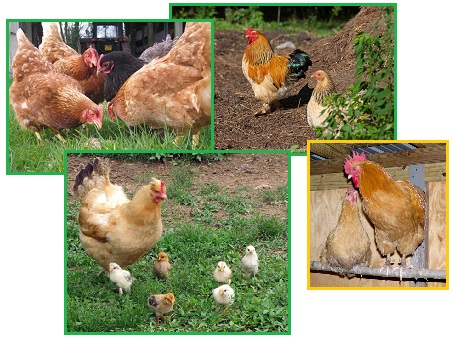 g g
ZetaTalk Suggestion
12/2003: Chickens
eat bugs, forage for themselves, and come home to lay their
eggs if given a safe and private roost. Ducks likewise eat
whatever grows in or around ponds, which will be numerous in
the drizzle, and don't require a dry spot to roost. Goats,
which eat anything, can likewise be kept within limits if the
surrounding country can sustain them.
Goats are so omnivorous they are known to eat poison ivy, and as
herds have the advantage of bonding with their herdsman, and
will follow him or her anywhere. I’ve heard from a goat-keeper
that they even give a type of hug, they are so affectionate.
Their manure is ideal, as manure goes, little pellets easily
gathered and transported. Goat milk, and goat cheese, are second
to none, superior to cow’s milk and cheese in many respects.
- Goat Keeping
http://eap.mcgill.ca/MagRack/COG/COG_H_96_02.htm
- Why goats? Manure that is easily
managed is just one of the many gifts provided by these
wonderful creatures. Fresh milk, cheeses, yogurt, meat,
skins, and fiber produced at home without the antibiotics,
hormones, and dyes sometimes present in the commercial
stuff are a few other benefits. Goats are easy to care
for: chores take only about 20 minutes morning and
evening. These very hardy animals give birth with ease,
usually have multiple births and have very few health
problems. They can be kept on a small acreage and they are
economical: you can keep six to eight goats for the same
amount of feed it takes to keep one cow, and you’ll get
twice the milk. The cons? Goats will eat your garden and,
given half a chance, will bark your fruit trees and eat
your neighbor’s roses, so good fences are a must. You will
have to be dedicated, especially if you are milking:
usually, it’s required every 12 hours. You will need a
shelter for your goats, in the form of a shed, stable or
barn.
I’ve often noted how much grazing land is wasted along
roadways, where mowers cut down the tall grass and weeds and
there it lies, going to waste. After the pole shift, when cars
will lack gas and roads are heaved and broken, lawns and
roadsides will become pasture land. Cattle are not as efficient
as goats, and sheep require grasslands where goats prefer
shrubbery and brush. Overgrown former pasture land will thus be
ideal for goat herds, as the Congressional Cemetery in
Washington DC recently discovered. You will need to have your
garden fenced in any case to keep out any deer or wild rabbits.
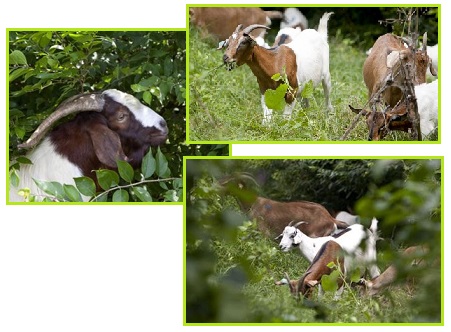
- Cemetery Fans: Goats 'Right Decision'
August 14, 2013
http://www.politico.com/story/2013/08/cemetery-goats-right-decision
- The goats ate almost everything
that was green in the 1.6-acre area. A visible line along
the trees shows where the goats could no longer reach.
|

